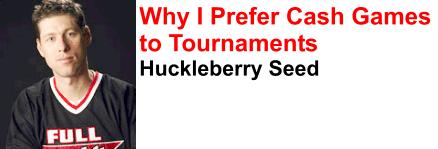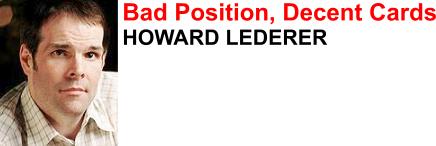On Cavemen and Poker Players

There are four possible outcomes for any session of poker. You might win a little, lose a little, win a lot, or lose a lot. Most of us react differently to the different outcomes. When we win big, we’re elated; when we lose big we’re upset. Think back to some recent bad beats. Do you recall feeling a rush of adrenaline and an overwhelming sense of rage? If you haven’t encountered this, you’re lucky; most players have.
I believe that reactions at the poker table are so strong because the game taps into a very primal portion of our brains. In poker, we’re fighting for something we view as critical – money. In these days of relative safety and comfort, our battles at the poker table are as close as we get to the life-and-death struggles that our ancient ancestors encountered. Eons ago, the adrenaline served a purpose – it triggered a response critical to survival. Without thought or reason, ancient man knew two things: Fight or flee. The quick surge of panic and anger kept the species alive.
At the poker table, however, the same response serves no useful purpose. You can’t beat the dealer over the head with a rock. Screaming in panic and running from the room isn’t a great idea either. So most of us just steam – we tilt. With no outlet for the excess chemicals, we sit at the table, angry, while our judgment becomes clouded. Maybe we blast off some money or run a ridiculous bluff as a way to relieve the pressure.
The thing is, you need to overcome these instinctual reactions if you’re going to become a consistent winner at poker. It’s not easy to control the instinctual part of your brain, but it’s something that you can work on every time you play poker. Endeavor to leave each session in the same emotional state. If you win big, keep yourself from getting too excited. Remind yourself that this is just one session that has gone well, and that another is bound to go poorly. Reverse the argument after a big loss.
I believe that if you commit to engaging the thinking, reasoning portion of your brain at every opportunity you can, in time, overcome the primal reactions. It isn’t easy. Some players with incredible mastery of the game are long-term losers because they can’t get a handle on their emotions.
Embrace the challenge of evening your emotional responses. It may be the most important thing you can do to improve your poker results.
Ben Roberts
 If you’re USA-based, like Ben, you can play some great online at Bookmaker Poker or BetOnline Poker.
If you’re USA-based, like Ben, you can play some great online at Bookmaker Poker or BetOnline Poker.




 “In the last couple of years, I’ve noticed that some of the less experienced players who have entered $10,000 buy-in tournaments don’t fully appreciate what they’ve seen on TV.”
“In the last couple of years, I’ve noticed that some of the less experienced players who have entered $10,000 buy-in tournaments don’t fully appreciate what they’ve seen on TV.”
 There’s lots of choice when it comes to poker networks including the iPoker Network, Microgaming Poker, Chico Poker and WPN Poker Networks. Check out the latest
There’s lots of choice when it comes to poker networks including the iPoker Network, Microgaming Poker, Chico Poker and WPN Poker Networks. Check out the latest 




